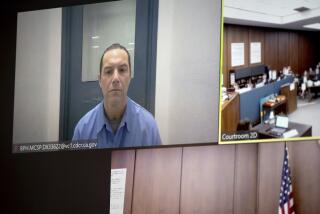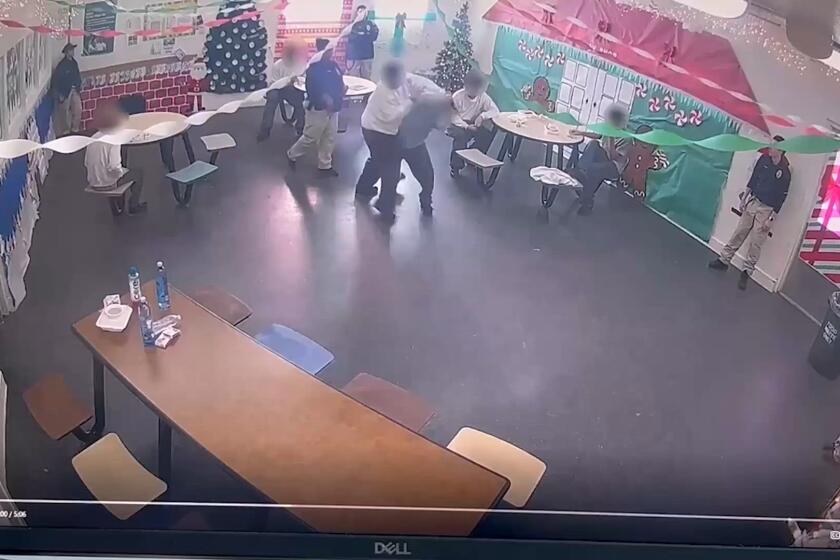City Ownership Seen as Way to Save Open Space
Like many local residents, John Gillies came to San Diego County as much for what it didn’t have as what it had.
When the Del Mar councilman moved here from Los Angeles in 1971, he was drawn by an area remarkably bereft of the gridlock of houses, apartments and factories that mark the megalopolis to the north. At that time, the only thing hemming in homeowners in the San Diego region was yawning valleys and hillsides covered with chaparral, he recalls.
Today, Gillies worries that the very assets that lured urban refugees like him to the area are in jeopardy. As he sees it, the open space that distinguished San Diego County from more congested areas is swiftly and surely being nibbled away by development.
“When I first came to San Diego, the thing I felt was so remarkable was these big, undeveloped areas coming right up to the freeways,” Gillies said. “But now we’re seeing open spaces we took for granted disappearing.”
While most residents acknowledge that some measure of growth is inevitable for the San Diego area, the question of how much land should be set aside for scenic greenbelts is becoming an increasingly vital topic as the region matures.
In several cities, the debate over open space has spawned grass-roots movements aiming to preserve unblemished territory the old-fashioned way--by buying it.
Lawmakers in San Diego and Del Mar in recent months have begun discussing plans to purchase vacant property near the environmentally sensitive San Dieguito Lagoon, an area threatened by a hotel and commercial project. Many elected officials and residents envision acquisition of that acreage as the first step toward preserving a 43-mile stretch of the San Dieguito River Valley as a regional park.
In Carlsbad, city voters have taken it a step further, approving a ballot measure last month that directs officials to purchase Hosp Grove, a scenic eucalyptus forest targeted for residential development. Some residents have also talked of pushing for the purchase of other open-space areas throughout Carlsbad as part of a multimillion-dollar municipal bond issue being proposed to pay for Hosp Grove.
An Escondido planning commissioner, meanwhile, has begun to seek signatures on a petition to qualify a ballot initiative that would, among other things, require the city to set aside one acre of open space for every 100 dwelling units that are built.
City fathers in Vista have taken a different tack, agreeing to form an agricultural land foundation to protect farmland in the community. Under the plan, a builder could voluntarily trade off agricultural land for density bonuses or other development rights. While the preservation of unfettered open space is not the principal aim of the program, Vista officials note that it will nonetheless help retain pockets of visual relief as the city continues to grow.
Stopgap Measure?
Despite such strides, skeptics remain. Some public officials are convinced that efforts such as buying land to keep it free from development are little more than stopgap measures fraught with problems.
In particular, they note that local municipalities are particularly hard pressed to come up with the cash needed to purchase large parcels of land and allow them to remain in a natural state. Moreover, once land is purchased by a city and set aside as open space, it typically falls on city officials to handle maintenance and liability problems.
Carlsbad City Manager Frank Aleshire said the concept of using operating funds to purchase open space is relatively rare and poses budgetary and operational headaches. He prefers the notion of developers providing open space as part of a project, with a homeowners’ association assuming the responsibility for maintaining the virgin territory.
“The city does not have a budget to purchase open space,” Aleshire said. “It’s not part of the city’s overall plan to use taxpayer money to buy open space.”
Carlsbad, like most cities, has used its zoning laws to outline those areas that will remain undeveloped. According to Aleshire, nearly 40% of the city is zoned as open space under existing land-use plans.
“We’ve got the lagoons and steep canyons that can’t be developed,” Aleshire said. “We’re going to have a lot of open space because of the terrain and character of the area we live in. We’re not going to be boxed in by subdivisions, cheek to jowl. There’s no way we’re going to look like Los Angeles or Orange County, that vast plain of development.”
But open-space advocates argue that land-use planning can only go so far to protect aesthetically pleasing strips of land. Zoning laws, they note, can be swiftly amended by a council sympathetic to the desires of a landowner or developer.
“Buying land is the only way you can truly be sure an area is preserved as open space,” San Diego Councilwoman Abbe Wolfsheimer said. “You can have land uses that change from council to council. Sometimes you’ll have very sensitive councils, sometimes there will be a majority that will not want to preserve the land.”
Gillies agreed, arguing that the realities of the political system give the development industry a tremendous advantage over grass-roots citizens’ groups often hurting for cash.
“Let’s face it, the big money, the big business, has always been in construction,” he said. “A lot of politicians have gotten where they are with campaign funds supplied by the construction industry. It’s hard for them to change their spots.”
Buying land for public use also takes it off the tax rolls, which can be viewed as a long-term expense.
Despite such sentiments, open-space advocates have scored victories in recent years.
Perhaps the most notable was the success of the Hosp Grove ballot measure in Carlsbad last month. If anything, the measure’s narrow win at the polls proved that persistence pays off.
A loose-knit coalition of environmentalists and residents formed about a year ago to protest a 216-unit condominium complex planned in the 60-acre grove, a dense stand of eucalyptus trees that covers the hills rising from the southern shore of Buena Vista Lagoon near California 78 and Interstate 5.
Although the group managed to convince the council to temporarily block the project in March, 1986, it later ran into trouble--a November initiative calling for nearly $6 million to buy the grove failed to muster the two-thirds vote required for such bond measures. Undeterred, the group got the council to put the issue back on the ballot, this time as an advisory vote requiring a simple majority since the sale of bonds was not involved.
After a divisive campaign in which Old Guard residents and businessmen blasted the proposed deal as a budget-busting nightmare, city residents approved the purchase.
Now, as Carlsbad officials grapple with how best to fund the transaction, supporters of Hosp Grove are taking aim at other potential open-space acquisitions.
While some council members are dead set against the idea of purchasing additional parcels of land in Carlsbad, the open-space advocates are quietly pushing for just that. They would like to see more land bought as part of a massive, $15- to $20-million bond measure being proposed to pay for Hosp Grove as well as several public works projects in various parts of the city.
“We can’t stop development and we’re not going to,” said Dan Hammer, a leader of Friends of Hosp Grove, the citizens’ group that worked to spare the eucalyptus forest. “The point is to find out which areas are near and dear to us, and then take care of them before the blueprints are drawn up and the landowners and developers have spent a lot of money.”
Aside from bond issues, the city could purchase raw land by using federal grants or getting financial assistance from groups such as the Nature Conservancy or the Trust for Public Lands, Hammer said. Private foundations, such as the local organizations that now serve as stewards for the area’s lagoons, could be established to act as guardians for the open space, he said.
Above all, Hammer stressed that acquisition of substantial tracts of vacant land is vitally needed to preserve the area’s natural beauty for future generations. But he also noted that there are economic benefits for homeowners.
“I think open space makes sense on the ledger sheet,” Hammer said. “If open spaces are retained, Carlsbad will be the quality city of North County. People would see their property values rise tremendously.”
Other Open Areas
Such arguments are echoed by Wolfsheimer, Gillies and others pushing for preservation of the San Dieguito River Valley.
“I think we’re all very cognizant of the fact that unless we do something now, the area along the San Dieguito River could in 20 years or so conceivably look something like Mission Valley,” Wolfsheimer said. “The time to act is now.”
In particular, developers are eyeing the valley’s flat, western flank between Del Mar and Rancho Santa Fe as a potential site for industrial parks and other commercial projects, she said.
Several steps have already been taken to head off development of the river valley before it can occur.
San Diego planners have begun a land-acquisition study focusing on 750 acres tucked between Interstate 5 and El Camino Real. The study will attempt to determine the land-use potential of individual properties, rank which parcels should be purchased and recommend possible property trades, acquisitions or transfers. City officials are looking at grants and some of the money left from a $65-million open-space bond issue approved in 1978 as ways to fund the purchase of parcels.
In Del Mar, city officials have ordered an appraisal on a 100-acre parcel near the San Dieguito Lagoon west of Interstate 5. A developer has discussed building a hotel on the land, but officials in both Del Mar and San Diego are seriously considering the idea of buying the property so it can be preserved as wetland.
Finally, a group of area residents has formed the San Dieguito River Valley Land Conservancy in hopes of serving as a foundation to oversee purchase of property along the waterway.
Nancy Weare, president of the conservancy, said the group’s broad goal is to create an open-space park, stretching from the ocean to the foothills. Although such a facility would be largely dedicated to preservation of the natural topography, it could include areas dedicated for hiking, light boating, archeological sites, museums, a golf course and botanical preserves.
“I think we would like to see the river valley left as undeveloped as possible,” Weare said. “It all sounds pretty ambitious, but really the only other regional park we have is Balboa.”
Currently, most of the area along the river is zoned for extremely low-density use--about one house per 10 acres. In addition, sections within San Diego have the added protection of Proposition A, the momentous land-use initiative approved in 1985 that requires a vote of the people on new developments in the so-called “future urbanizing area.”
Despite such protections, open-space advocates like Weare say the time to act is now.
“Obviously, you can’t buy all of it,” she said. “But with enough community support, we’re hoping that our legislators maintain the current zoning. This is one of the last open spaces.”
More to Read
More to Read
More to Read
Start your day right
Sign up for Essential California for news, features and recommendations from the L.A. Times and beyond in your inbox six days a week.
You may occasionally receive promotional content from the Los Angeles Times.






